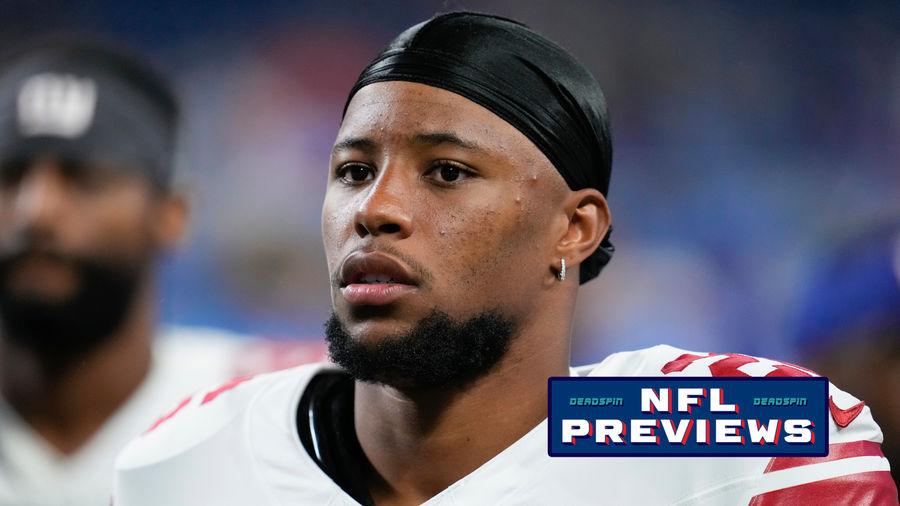The need for workhorse NFL running backs is declining — it isn’t personal, it’s evolution
 Saquon Barkley is a transcendently skilled running back working without a commensurately huge salary. source: AP
Saquon Barkley is a transcendently skilled running back working without a commensurately huge salary. source: AP
Saquon Barkley is worth more than what his contract pays him. Rudy Gobert is working on his three-pointer because most think he isn’t worth what his contract pays him. Both men and the positions they play have something in common — they’re becoming casualties of war as their sports advance, as it’s survival of the fittest for NFL running backs and traditional centers in the NBA. You either adapt or die.
So, how did we get here?
The same way we went from leather helmets to those huge Guardian padded helmet caps players wear in practice — evolution.
Quarterbacks rarely line up under center, offensive coordinators abandoned the Wing-T a long time ago, and the H-Back position is a thing of the past. Players develop. The game changes. Positions get left behind. In the NFL, it’s the workhorse running back. In the NBA, it’s the traditional center. While they’re still needed at times, the usefulness of two positions that used to be their sports’ more glamorous roles on the court/field, have been greatly reduced.
Nothing lasts forever, and the way these positions are viewed — and paid — has changed.
In a moment in which NFL running backs are pissed due to it feeling like every other position’s salaries are going up — while they’re constantly being devalued in salary, but not workload — the conversation, which started in the offseason, is destined to be a hot topic all year as we approach the kickoff of the 2024 season.
“Unfortunately, there is a prevalent assumption made by all of these teams that these top running backs aren’t worth investing into beyond four years, and it’s not true,” legendary running back Marcus Allen said in a recent interview.
“You have to value these guys, and they’re sadly undervalued,” added Allen. “It’s a copycat league, so one team follows the other when it comes to valuing running backs. It’s prevalent, and I don’t know if it will change, but I’ll be watching and hope it does change. … It’s intellectually dishonest.”
Things came to a head earlier this summer when Barkley, of the New York Giants, and Las Vegas Raiders running back Josh Jacobs were upset with their contracts. The Raiders hit Jacobs with the franchise tag instead of giving him a big contract after he carried them offensively last season. He’s been away from the team and still hasn’t signed the franchise tag deal. Barkley was in a similar situation as more salt was added to his wound when he had to watch the Giants sign offensive lineman Andrew Thomas to an extension worth $117.5 million, including $67 million guaranteed, and give quarterback Daniel Jones $160 million.
Barkley, a man who carried the ball 313 times for 1,426 yards and 12 touchdowns during the 2022 regular season and playoffs, eventually folded and signed a one-year, adjusted franchise tag worth $10.1 million — the math isn’t “mathing.”
“Some people may agree or disagree with this, to sit out or sit in,” said Barkley after the deal was done, and after he had previously threatened to hold out for the entire season. “And this year, specifically, I felt like the best thing I could do for myself would be coming back, playing the game that I love, playing for my teammates, doing something I’ve wanted to do since I was a little kid.”
Dalvin Cook was in a similar situation in Minnesota. The former Vikings back that made the Pro Bowl the last four seasons, rushed for 1,173 yards and eight touchdowns during the regular season before he was released in June. After initially having signed a five-year, $63 million contract extension with Minnesota in 2020, he’s now a member of the New York Jets after they picked him up on a one-year deal worth $8.6 million.
Tailbacks seem to be in a no-win situation. There will always be open positions on the market, but now they come with lower salaries despite not much alteration to their job description. It’s a concerning situation that has all-time greats wondering what the future will look like.
“Your job is tough, man,” Hall of Fame running back Terrell Davis told Jim Trotter of The Athletic. “It’s going to be sad because there will be some really good backs, I mean, maybe some all-time backs, who won’t get a chance to even show that they deserve to be in the Hall because they’re going to be limited in opportunities.”
In today’s game, the do-everything back is what’s desired most. Being able to pick up tough yards or break one open isn’t good enough anymore. You have to be able to block, catch a lot of passes out of the backfield, and even be able to line up and be used as a wide receiver at times. The more you can do, the better. In the past that resembled a guy like Percy Harvin, now you see it in backs like Christian McCaffrey and WR/RB Deebo Samuel.
“To have that option to do that, you can’t do that with anybody, you have to do that with a special player, and Deebo is a special player,” said 49ers head coach Kyle Shanahan after Samuel signed his three-year contract extension worth up to $73.5 million last summer. Much of the friction around the negotiations came down to San Francisco using the wide receiver as a running back, and Samuel wanting wide receiver money compared to running back money, despite what was best for the offense. It’s why Samuel’s contract is full of incentives based on his production as a ball carrier. “And I think that’s why he’s earned this contract that he’s got. And I think that’s why he is going to continue to earn it going forward,” added Shanahan.
To some, there are beliefs that race has played a role in the devaluing of a position that feels like only Black players occupy. But on this rare occasion, when it comes to the NFL, it’s less about racism and, oddly enough, more about equality.
Take a look around, Black quarterbacks have taken over the NFL. Unfortunately, because of the way the game is now played, it’s taking place at a time in which Black running backs are being paid like part-time employees. Black — and white — quarterbacks are becoming more mobile in and out of the pocket, as offensive coordinators have finally realized that dual-threat pass throwers give you more options. And since quarterbacks are running more, that means running backs are getting fewer carries — especially in a pass-happy era.
For instance, in February, Jalen Hurts and Patrick Mahomes made history as the first two Black quarterbacks to ever face off in the Super Bowl. And in April, Bryce Young, C.J. Stroud, and Anthony Richardson made history as Black quarterbacks went first, second, and fourth overall in the 2023 NFL Draft. All three are expected to be the starters for Week 1.
The evolution of football going from three yards and a cloud of dust to an uptempo style that focuses on getting players in space, which has been dubbed by some as basketball on grass, is simultaneously happening as traditional centers are becoming archaic in the NBA. Back-to-the-basket big men are out, as teams play outside-in instead of inside-out now. There aren’t many plays run for centers to get low on the block and bang with their defenders. If you can’t shoot from the outside or have the lateral quickness to guard 1-through-5, you’ll be sitting on the bench. Teams prefer big men that can defend the rim, run the floor, set screens, hit perimeter jumpers, and switch out on little guys on the wing — thats’ the new job description for an NBA center.
Jump hooks are out. Jumpers are in.
“I’m the greatest big-man shooter of all time. That’s a fact. You can see the stats,” said Minnesota Timberwolves center Karl-Anthony Towns in 2021. During the 2020-2021 season, the 7-foot, 248-pound big man hoisted 315 threes and made 38.7 percent of them. “I ain’t got to play like no one else. Everyone trying to find themselves to be the second version of me when I’m the first version. I don’t got to be the second version of someone else. I’m already an original. I don’t have to be a duplicate of someone else.”
The following season, his attempts from deep jumped to 366 as he upped his percentage to 41 percent.
“When my time’s up and I retire…there’s going to be people who are going to say that I changed the game,” Towns said on The Pat Bev Podcast With Rone in June.
At some point, things will come back around. Workhorse NFL running backs will once again be viewed, respected, and paid like one of the most important positions on the field like yesteryear in the same way that centers in basketball will return to the post to do the majority of their work. But until that day comes, ball carriers — like big men — have two choices. Add more things to your game so that you’re a commodity, or draw a line in the sand and see if your sport can survive without you.

